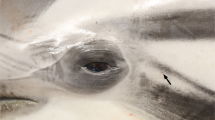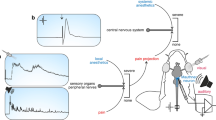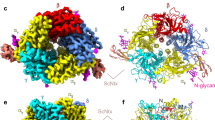Abstract
CONDUCTION of the nervous impulse depends on voltage-sensitive change in the permeability of the nerve cell membrane to sodium ions. The sodium channels that appear during the action potential can be blocked very specifically by various neurotoxins, including tetrodotoxin (TTX) from the puffer fish and saxitoxin (STX) from certain marine algae1. Shrager and Profera2 presented evidence that the binding of TTX to crab nerves is reduced after treatment with a water-soluble carbodiimide and glycine methyl ester as the associated nucleophile. In these chemically modified nerves it follows that the sodium channels should have been rendered insensitive to TTX. Shrager and Profera were unable to test this prediction because in their experiments the nerves became inexcitable after chemical treatment.
This is a preview of subscription content, access via your institution
Access options
Subscribe to this journal
Receive 51 print issues and online access
$199.00 per year
only $3.90 per issue
Buy this article
- Purchase on Springer Link
- Instant access to full article PDF
Prices may be subject to local taxes which are calculated during checkout
Similar content being viewed by others
References
Narahashi, T., Physiol. Rev., 54, 813–889 (1974).
Schrager, P., and Profera, C., Biochim. biophys. Acta, 318, 141–146 (1973).
Colquhoun, D., and Ritchie, J. M., J. Physiol., Lond., 221, 533–553 (1972).
Smith, M., Moffatt, J. G., and Khorana, H. G., J. Am. chem. Soc., 80, 6204–6212 (1958).
Kurzer, F., and Douraghi-Zadeh, K., Chem. Rev., 67, 107–151 (1967).
Tener, G. M., and Khorana, H. G., J. Am. chem. Soc., 77, 5349–5351 (1955).
Brown, D. M., Adv. Org. Chem., 3, 95–157 (1963).
Chambers, R. W., Moffatt, J. G., and Khorana, H. G., J. Am. chem. Soc., 79, 4240–1 (1957).
Chanley, J. D., and Feageson, E., J. Am. chem. Soc., 80, 2686 (1958).
Halman, M., Lapidot, A., and Samuel, D., J. Am. chem. Soc., 82, 4672–4677 (1960).
Cox, J. R., Jr, and Ramsay, O. B., Chem. Rev., 64, 317–352 (1964).
Di Sabato, G., and Jencks, W. P., J. Am. chem. Soc., 83, 4400–4405 (1961).
Lipmann, F., and Tuttle, L. C., J. biol. Chem., 153, 571 (1944).
Bunton, C. A., and Fendler, J. H., J. org. Chem., 30, 1365–1371 (1965).
Fisher, E., Ber. Deut. Chem. Gesch. (Berlin), 39, 453–474 (1906).
Abbott, B. C., Hill, A. V., and Howarth, J. V., Proc. R. Soc., B 148, 149–187 (1958).
Moore, J. W., Narahashi, T., and Shaw, T. I., J. Physiol., Lond., 188, 99–105 (1967).
Keynes, R. D., Ritchie, J. M., and Rojas, E., J. Physiol. Lond., 213, 235–254 (1971).
Kao, C. Y., Pharmac. Rev., 18, 997–1049 (1966).
Author information
Authors and Affiliations
Rights and permissions
About this article
Cite this article
BAKER, P., RUBINSON, K. Chemical modification of crab nerves can make them insensitive to the local anaesthetics tetrodotoxin and saxitoxin. Nature 257, 412–414 (1975). https://doi.org/10.1038/257412a0
Received:
Accepted:
Issue Date:
DOI: https://doi.org/10.1038/257412a0
Comments
By submitting a comment you agree to abide by our Terms and Community Guidelines. If you find something abusive or that does not comply with our terms or guidelines please flag it as inappropriate.



